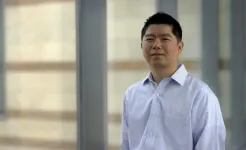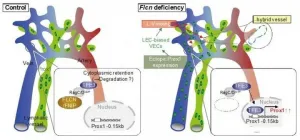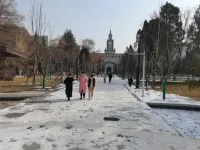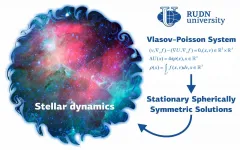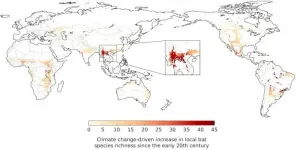INFORMATION:
- Written by Jeremy Agor, College of Engineering
UTA engineers develop programming technology to transform 2D materials into 3D shapes
UTA breakthrough: 2D materials capable of forming complex 3D shapes
2021-02-05
(Press-News.org) University of Texas at Arlington researchers have developed a technique that programs 2D materials to transform into complex 3D shapes.
The goal of the work is to create synthetic materials that can mimic how living organisms expand and contract soft tissues and thus achieve complex 3D movements and functions. Programming thin sheets, or 2D materials, to morph into 3D shapes can enable new technologies for soft robotics, deployable systems, and biomimetic manufacturing, which produces synthetic products that mimic biological processes.
Kyungsuk Yum, an associate professor in the Materials Science and Engineering Department, and his team have developed the 2D material programming technique for 3D shaping. It allows the team to print 2D materials encoded with spatially controlled in-plane growth or contraction that can transform to programmed 3D structures.
Their research, supported by a National Science Foundation Early Career Development Award that Yum received in 2019, was published in January in Nature Communications.
"There are a variety of 3D-shaped 2D materials in biological systems, and they play diverse functions," Yum said. "Biological organisms often achieve complex 3D morphologies and motions of soft slender tissues by spatially controlling their expansion and contraction. Such biological processes have inspired us to develop a method that programs 2D materials with spatially controlled in-plane growth to produce 3D shapes and motions."
With this inspiration, the researchers developed an approach that can uniquely create 3D structures with doubly curved morphologies and motions, commonly seen in living organisms but difficult to replicate with man-made materials.
They were able to form 3D structures shaped like automobiles, stingrays, and human faces. To physically realize the concept of 2D material programming, they used a digital light 4D printing method developed by Yum and shared in Nature Communications in 2018.
"Our 2D-printing process can simultaneously print multiple 2D materials encoded with individually customized designs and transform them on demand and in parallel to programmed 3D structures," said Amirali Nojoomi, Yum's former graduate student and first author of the paper. "From a technological point of view, our approach is scalable, customizable, and deployable, and it can potentially complement existing 3D-printing methods."
The researchers also introduced the concept of cone flattening, where they program 2D materials using a cone surface to increase the accessible space of 3D shapes. To solve a shape selection problem, they devised shape-guiding modules in 2D material programming that steer the direction of shape morphing toward targeted 3D shapes. Their flexible 2D-printing process can also enable multimaterial 3D structures.
"Dr. Yum's innovative research has many potential applications that could change the way we look at soft engineering systems," said Stathis Meletis, chair of the Materials Science and Engineering Department. "His pioneering work is truly groundbreaking."
ELSE PRESS RELEASES FROM THIS DATE:
Ensuring healthy family mealtimes is important - and complicated
2021-02-05
URBANA, Ill. ¬- Mealtimes are a central aspect of family life, affecting the health and wellbeing of both children and adults. Although the benefits of healthy mealtimes are straightforward, helping all families realize those benefits is quite complicated, new research from University of Illinois shows.
The study highlights ways in which some solutions - such as an exclusive focus on improving food access or on improving mealtime preparation and organization skills - may be less effective if done in isolation, says Allen Barton, assistant professor in the Department of Human Development and Family Studies at ...
How blood and lymph vessels remain separated after development
2021-02-05
Researchers from Kumamoto University (Japan) have clarified the mechanism by which blood and lymph vessels remain segregated from one another after development. The characteristics and structures of these two vessel types are very similar, and how they maintain separation has remained unexplained for many years. In this study, researchers found that the molecule Folliculin (FLCN) in vascular endothelial cells acts as a gatekeeper to maintain that separation.
Blood and lymphatic vessels form independent networks until the final confluence at the left and right venous angles in the neck. Blood vessels act as a pipeline that ...
Signs of burnout can be detected in sweat
2021-02-05
We've all felt stressed at some point, whether in our personal or professional lives or in response to exceptional circumstances like the COVID-19 pandemic. But until now there has been no way to quantify stress levels in an objective manner.
That could soon change thanks to a small wearable sensor developed by engineers at EPFL's Nanoelectronic Devices Laboratory (Nanolab) and Xsensio. The device can be placed directly on a patient's skin and can continually measure the concentration of cortisol, the main stress biomarker, in the patient's sweat.
Cortisol: A double-edged sword
Cortisol is a steroid hormone ...
Biosensors to detect P. jirovecii, responsible for Pneumocystis pneumonia
2021-02-05
The group led by Dr. Enrique J. Calderón - "Clinical Epidemiology and Vascular Risk" at the Institute of Biomedicine of Seville - IBiS/University Hospitals Virgen del Rocío and Macarena/CSIC/University of Seville, also a member of CIBERESP, participated in a project with researchers from CIBER-BBN, in which they developed systems to detect Pneumocystis jirovecii, an atypical fungus responsible for very severe pneumonia in immunosuppressed patients. The results have been published in the journals Nanomaterials and Journal of Fungi, and are the fruit of collaboration with the CIBER-BBN groups led by Dr. Laura Lechuga, ...
In-silico modelling helps with the integrated study of the intervertebral disc in health and disease
2021-02-05
The spinal column consists of 24 vertebrae that provide axial support to the torso and protection to the spinal cord that runs through its central cavity. The vertebrae are connected by means of intervertebral discs. These discs are highly hydrated, flexible and highly mechanically resistant. They allow the column its flexibility and act as shock absorbers during daily activities such as walking, running and in impact situations, such as jumping.
These unique features are made possible by the discs' tissue composition and structure. At its centre, there is a gel-like ...
Chinese scientists use knowledge from climate system modeling to develop a global prediction system for the COVID-19 pandemic
2021-02-05
At the time of writing, coronavirus disease 2019 (COVID-19) is seriously threatening human lives and health throughout the world. Before effective vaccines and specific drugs are developed, non-pharmacological interventions and numerical model predictions are essential. To this end, a group led by Professor Jianping Huang from Lanzhou University, China, developed the Global Prediction System of the COVID-19 Pandemic (GPCP).
Jianping Huang is a Professor in the College of Atmospheric Sciences and a Director of the Collaborative Innovation Center for Western Ecological Safety, Lanzhou University, China. He has for a long time been dedicated to studying ...
Mathematics developed new classes of stellar dynamics systems solutions
2021-02-05
The Vlasov-Poisson equations describe many important physical phenomena such as the distribution of gravitating particles in the interstellar space, high-temperature plasma kinetics, and the Landau damping effect. A joint team of scientists from the Mathematical Institute of RUDN University and the Mathematical Institute of the University of Munich suggested a new method to obtain stationary solutions for a system of Vlasov-Poisson equations in a three-dimensional case. The obtained solutions describe the phenomena of stellar dynamics. The results of the study were published in the ...
Climate change may have driven the emergence of SARS-CoV-2
2021-02-05
Global greenhouse gas emissions over the last century have made southern China a hotspot for bat-borne coronaviruses, by driving growth of forest habitat favoured by bats.
A new study published today in the journal Science of the Total Environment provides the first evidence of a mechanism by which climate change could have played a direct role in the emergence of SARS-CoV-2, the virus that caused the COVID-19 pandemic.
The study has revealed large-scale changes in the type of vegetation in the southern Chinese Yunnan province, and adjacent regions in Myanmar and Laos, over the last century. Climatic changes ...
Nehandertals' gut microbiota and the bacteria helping our health
2021-02-05
Neanderthals' gut microbiota already included some beneficial micro-organisms that are also found in our own intestine. An international research group led by the University of Bologna achieved this result by extracting and analysing ancient DNA from 50,000-year-old faecal sediments sampled at the archaeological site of El Salt, near Alicante (Spain).
Published in Communication Biology, their paper puts forward the hypothesis of the existence of ancestral components of human microbiota that have been living in the human gastrointestinal tract since before the separation between the Homo Sapiens and Neanderthals that occurred more than 700,000 years ago.
"These results allow us to understand which components of the human gut microbiota ...
Silicon anode structure generates new potential for lithium-ion batteries
2021-02-05
New research has identified a nanostructure that improves the anode in lithium-ion batteries
Instead of using graphite for the anode, the researchers turned to silicon: a material that stores more charge but is susceptible to fracturing
The team made the silicon anode by depositing silicon atoms on top of metallic nanoparticles
The resulting nanostructure formed arches, increasing the strength and structural integrity of the anode
Electrochemical tests showed the lithium-ion batteries with the improved silicon anodes had a higher charge capacity and longer lifespan
New research conducted by the Okinawa Institute of Science and Technology ...
LAST 30 PRESS RELEASES:
Making lighter work of calculating fluid and heat flow
Normalizing blood sugar can halve heart attack risk
Lowering blood sugar cuts heart attack risk in people with prediabetes
Study links genetic variants to risk of blinding eye disease in premature infants
Non-opioid ‘pain sponge’ therapy halts cartilage degeneration and relieves chronic pain
AI can pick up cultural values by mimicking how kids learn
China’s ecological redlines offer fast track to 30 x 30 global conservation goal
Invisible indoor threats: emerging household contaminants and their growing risks to human health
Adding antibody treatment to chemo boosts outcomes for children with rare cancer
Germline pathogenic variants among women without a history of breast cancer
Tanning beds triple melanoma risk, potentially causing broad DNA damage
Unique bond identified as key to viral infection speed
Indoor tanning makes youthful skin much older on a genetic level
Mouse model sheds new light on the causes and potential solutions to human GI problems linked to muscular dystrophy
The Journal of Nuclear Medicine ahead-of-print tip sheet: December 12, 2025
Smarter tools for peering into the microscopic world
Applications open for funding to conduct research in the Kinsey Institute archives
Global measure underestimates the severity of food insecurity
Child survivors of critical illness are missing out on timely follow up care
Risk-based vs annual breast cancer screening / the WISDOM randomized clinical trial
University of Toronto launches Electric Vehicle Innovation Ontario to accelerate advanced EV technologies and build Canada’s innovation advantage
Early relapse predicts poor outcomes in aggressive blood cancer
American College of Lifestyle Medicine applauds two CMS models aligned with lifestyle medicine practice and reimbursement
Clinical trial finds cannabis use not a barrier to quitting nicotine vaping
Supplemental nutrition assistance program policies and food insecurity
Switching immune cells to “night mode” could limit damage after a heart attack, study suggests
URI-based Global RIghts Project report spotlights continued troubling trends in worldwide inhumane treatment
Neutrophils are less aggressive at night, explaining why nighttime heart attacks cause less damage than daytime events
Menopausal hormone therapy may not pose breast cancer risk for women with BRCA mutations
Mobile health tool may improve quality of life for adolescent and young adult breast cancer survivors
[Press-News.org] UTA engineers develop programming technology to transform 2D materials into 3D shapesUTA breakthrough: 2D materials capable of forming complex 3D shapes
